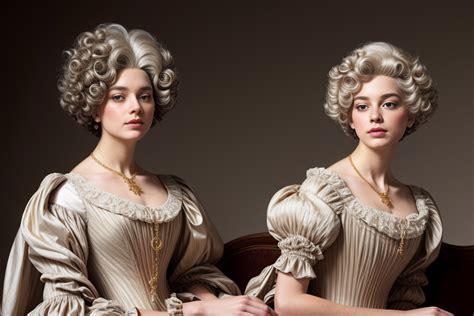French powder wigs, also known as “perukes,” emerged during the 17th century as a symbol of opulence and social status. Their elaborate designs and intricate craftsmanship made them an integral part of the aristocratic wardrobe during the Ancien Régime.

The Evolution of French Powder Wigs
The earliest powder wigs were relatively simple, with long, flowing curls that framed the face. As the fashion evolved, wigs became taller and more elaborate, incorporating elaborate braids, ribbons, and decorative ornaments. By the mid-18th century, wigs had reached their peak of grandeur, with towering structures that often reached heights of over two feet.
The Royal Court and the Powder Wig
The French court was the epicenter of wig fashion. Louis XIV, the “Sun King,” famously wore elaborate wigs adorned with diamonds and feathers. His courtiers eagerly emulated his style, leading to an explosion in wig making and a thriving wig trade.
The Powdering Ritual
To maintain their pristine white color, wigs were meticulously powdered with a mixture of wheat flour or starch. This process, known as “powdering,” was an elaborate ritual that could take hours. Servants would sift the powder over the wig using a special brush or bellows.
Fun Fact: According to the Musée de la Coiffure in Paris, a single wig could require up to a pound of powder per week.
The Decline of the Powder Wig
By the end of the 18th century, the popularity of powder wigs began to decline. The French Revolution and the rise of the Enlightenment led to a shift in fashion towards simpler and more natural styles. By the 19th century, powder wigs had become a symbol of the ancien régime and were largely abandoned.
The Legacy of the Powder Wig
Despite their disappearance from everyday fashion, powder wigs remain an important part of historical reenactment, theater, and costume design. They serve as a tangible reminder of a bygone era, when wigs were a symbol of power, status, and extravagance.
Modern Applications of the French Powder Wig
While powder wigs no longer play a significant role in daily fashion, their unique aesthetic and historical significance have inspired new and innovative applications.
The Art World
Contemporary artists have incorporated powder wigs into their work to explore themes of history, identity, and the ephemeral nature of beauty. For example, photographer Tierney Gearon created a series of images depicting women in powder wigs that challenged traditional notions of femininity.
Historic Reenactment
Powder wigs are an essential part of historic reenactment, allowing participants to immerse themselves in the customs and practices of the past. Historical reenactors use wigs to recreate the appearances of aristocrats, soldiers, and other figures from the 17th and 18th centuries.
Fashion Design
Fashion designers have drawn inspiration from the elaborate details and silhouettes of powder wigs. Contemporary designers have created modern interpretations of wigs, incorporating elements of the past with contemporary materials and techniques.
Themed Events and Parties
Powder wigs are a popular choice for themed events and parties that seek to evoke the atmosphere of the past. Guests can dress up in full period costume, complete with wigs, to celebrate weddings, anniversaries, or other special occasions.
Common Mistakes to Avoid When Using Powder Wigs
When working with powder wigs, it is important to avoid common mistakes that can damage or alter their appearance:
- Using too much powder: Excessive powder can weigh down the wig and make it appear stiff and unnatural.
- Not brushing the powder thoroughly: Powder must be brushed out completely to prevent it from clumping or discoloring the wig.
- Storing the wig improperly: Wigs should be stored in a cool, dry place away from direct sunlight. Avoid using mothballs or other harsh chemicals.
- Cleaning the wig too often: Powder wigs should only be cleaned when absolutely necessary. Over-washing can damage the wig and remove the powder.
Pros and Cons of French Powder Wigs
Pros:
- Adds a touch of historical authenticity to events or reenactments
- Provides a unique and eye-catching accessory for parties or themed events
- Can help create a sense of atmosphere and immersion
Cons:
- Can be expensive to purchase and maintain
- Requires special care and handling to avoid damage
- May not be suitable for all occasions or environments
Tables to Summarize Key Points
Table 1: Timeline of French Powder Wig Evolution
| Period | Characteristics |
|---|---|
| 17th Century | Long, flowing curls |
| Early 18th Century | Taller wigs with braids and ribbons |
| Mid-18th Century | Peak of grandeur, wigs reach heights of over two feet |
| Late 18th Century | Decline in popularity, simpler styles emerge |
Table 2: Key Figures in French Powder Wig History
| Figure | Role |
|---|---|
| Louis XIV | Championed powder wigs as a symbol of royal authority |
| Marie Antoinette | Known for her elaborate and extravagant wigs |
| François Boucher | Court painter who frequently depicted powder wigs in his portraits |
Table 3: Modern Applications of French Powder Wigs
| Application | Purpose |
|---|---|
| Art World | Exploration of history, identity, and the ephemeral nature of beauty |
| Historic Reenactment | Authentic recreation of appearances from the past |
| Fashion Design | Inspiration for modern interpretations of wigs |
| Themed Events and Parties | Evoke the atmosphere of the past |
Table 4: Common Mistakes to Avoid with Powder Wigs
| Mistake | Consequences |
|---|---|
| Using too much powder | Stiff, unnatural appearance |
| Not brushing the powder thoroughly | Clumping, discoloration |
| Storing the wig improperly | Damage, deterioration |
| Cleaning the wig too often | Removal of powder, damage |
